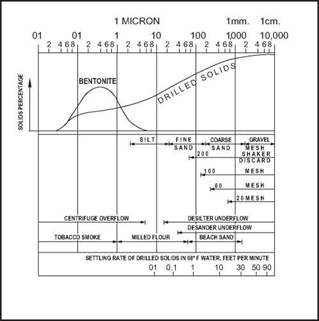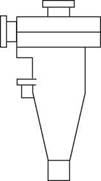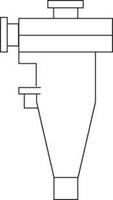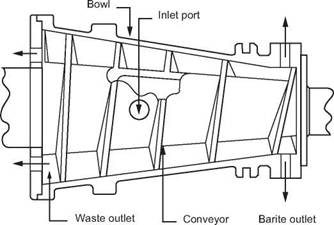 Solids Control Equipment
Solids Control Equipment
The mechanical components of solids control are:
a. Vibrating Screens
The screen is designed to remove the particles which will not pass through the mesh. At the same time the screen is vibrated to prevent blinding or plugging which would lower its efficiency. The size of the mesh on most shale shakers is 10 — 14 API mesh. (A 10 mesh screen has 10 openings per inch along each side). Many of the cuttings will pass through the 10 mesh screen since they have disintegrated due to erosion and hydration. For this reason a finer mesh (80 openings per inch) may be used. The screens can be arranged in series so that a finer mesh is put beneath the coarser mesh. Sometimes the screens are arranged in parallel to handle larger volumes, with a slight overlap to ensure no cuttings by-pass the screening. It must be remembered that the use of a finer screen means that the flow area of the screen is reduced. While drilling surface hole a large volume of cutting must be screened so there may be a physical limitation on the size of the mesh (unless the area of the screen can be increased). Fine screens are also susceptible to damage and need to be replaced. Oblong screens are sometimes used to extend the life of the screen. The mesh is different in each direction, which allows the use of heavier wire (i. e. 30 x 70 mesh). This increases the flow rate capacity but the cleaning efficiency is reduced.
As can be seen from the particle size distribution (Figure 17) an 80 mesh screen will only remove a small percentage of the total solids in the mud. Due to the small size of the particles the most convenient unit of measurement is the micron (1 inch = 25400 microns). The API
classification defines 3 sizes of particle as shown in Figure 17
|
Figure 17 Particle Size Distribution for Solids |
• Sand describes any particle > 74 microns. (Such particles may actually be shale or LCM, but they are sand size). This corresponds to material retained on a 200 mesh screen.
• Silt describes any particle between 2 and 74 microns.
• Colloidal describes any particle < 2 microns.
|
|
|
Save |
|
Discard |
|
I |
Notice from Figure 17 that barite comes within the silt category and bentonite is colloidal. API specifications for barite require that 97% of particles will pass through a 200 mesh screen. Screen sizes finer than 200 mesh cannot be used in weighted muds since the cost of replacing the discarded barite would be prohibitive.
|
X |
|
Discard t |
|
|
I
Save
Figure 19 Barite salvage system where the solids in the underflow are saved
b. Hydrocyclones
Hydrocyclones are designed to remove all the sand particles and most of the silt particles from the mud while retaining the colloidal fraction. Hydrocyclone is a general term which includes desanders (6" diameter or greater), desilters (generally 4" diameter), and clay ejectors (2" diameter). The operating principle of the hydrocyclone is the same irrespective of size (Figure 18). A centrifugal pump feeds mud tangentially at high speed into the housing, thus creating high centrifugal forces. These forces multiply the settling rate so that the heavy particles are thrown against the outer wall and descend towards the outlet (underflow). The lighter particles move inwards and upwards as a spiralling vortex to the liquid discharge (overflow). Hydrocyclones are designed so that only solids (plus small volume of fluid) passes out the underflow. This should appear as a “spray discharge” and not “rope discharge”. Rope discharge is an indication of solids overloading, and the underflow will soon plug off completely.
|
Figure 20 Hydrocyclone Cut-off Points |
Figure 18 shows the normal operation of a hydrocyclone with the solids being discarded. The cut point of a hydrocyclone is the particle size at which 50% of the particles of that size will be discarded (Figure 20). A typical cut point for a desander is 40 microns and for a desilter 20 microns. Since the particle size of barite lies between 2 and 80 microns hydrocyclones cannot be run with weighted muds since about half the barite would be removed through the underflow. Notice that for a clay ejector (Figure 19) the outlets are reversed (i. e. the underflow containing valuable barite is returned to the active system while the overflow containing finer material is discarded). Such devices are installed for barite salvage for weighted muds. Notice that there are no internal moving parts in a hydrocyclone, the separation is due solely to the settling action of particles with different densities.
|
Figure 21 Decanting centrifuge |
|
X |
c. Decanting Centrifuge
Centrifuges were first introduced to control solids and to retain the barite in weighted water based muds. However they may also be used in unweighted muds and oil muds to process the hydrocyclone underflow and return the liquid colloidal fraction to the active system.
A decanting centrifuge is shown in Figure 21. It consists of a rotating cone shaped bowl and a‘screw conveyor. As the centrifuge rotates at high speed the heavier particles are thrown against the side of the bowl. The screw conveyor moves these particles along the bowl and carries them towards the discharge port. At the opposite end is another port where liquid containing the finer particles is discharged.
For a weighted mud the underflow from the shale shaker is led to the centrifuge (no hydrocyclones used). The solids discharged through the underflow contain valuable barite and are returned to the active system. Centrifuges are more efficient than hydrocyclones for barite salvage since they make a finer particle cut. Under proper operating conditions 90 — 95% of barite can be salvaged. When drilling hydratable shales the finer drill solids must be controlled. The finer solids in the liquid phase are normally discarded, although this will also contain chemicals and barite.
For an unweighted mud the underflow from the desilters is led to the centrifuge. This time the liquid phase, containing the fine material (including bentonite), will be returned to the mud, while the solids will be discarded. This is often used in oil-based muds where the liquid phase will contain base oil which is expensive to replace. Water wet solids in an oil-based mud can be difficult to control, but a centrifuge can separate them from the liquid-colloidal phase. The solids are then dumped since they cannot be re-used.
d. Mud Cleaner
A mud cleaner is designed to remove drill solids larger than barite. It consists of a desilter and a screen, and so removes solids in two stages. It is used for a weighted mud to remove solids while retaining barite.. First the mud passes through the shale shaker, which should be as fine as possible and still accommodate the full mud flow. The underflow is then passed through a bank of desilters, where the overflow (lighter material) is returned to the active system. The underflow is directed onto the screen (usually 150 — 200 mesh). The barite particles will pass through and are returned to the system (together with very fine solids). The solids separated out by the screens are discarded. Mud cleaners have been developed by most mud companies under the names “silt separator” or “sand separator”. They can be used with decanting centrifuges if necessary. Both weighted and unweighted muds can be processed, as can oil-based muds. They are best suited for muds less than 15 ppg. (For heavier muds a centrifuge is better.)




